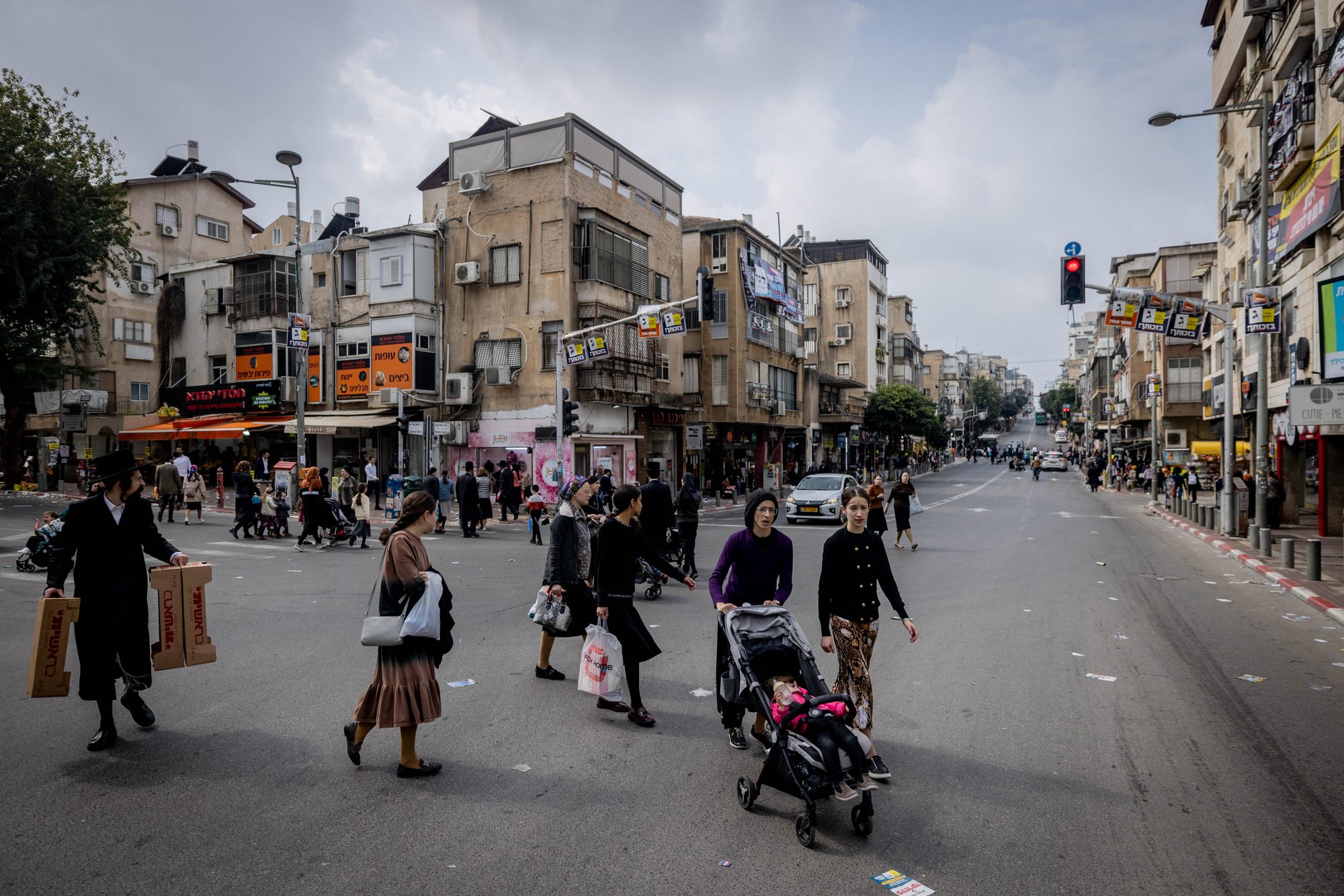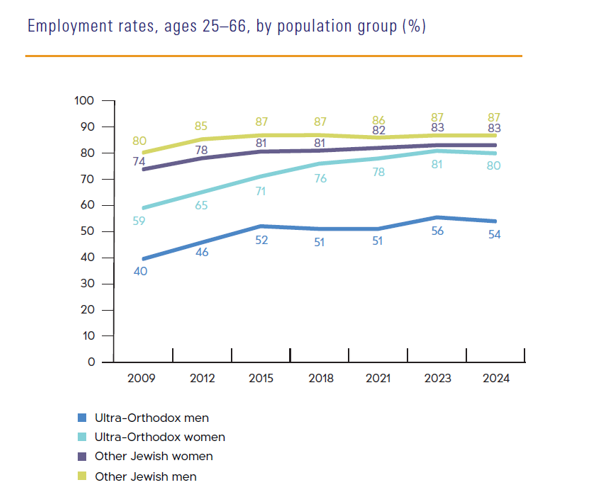The Israel Democracy Institute Releases its 2024 Statistical Report on Ultra-Orthodox Society

Photo by: Chaim Goldberg/Flash90
Yeshiva and kollel students:
There was a dramatic increase of 8.5% in the number of yeshiva students in January 2024 relative to January 2023. This is the largest increase we have seen since 2015.
Over the last decade, the number of yeshiva and kollel students has risen by 83%, while the number of Haredim enlisting in the IDF has fallen by 36%.
***
Slowdown in employment:
Data for 2024 (not final) indicate a slowdown in the rise of the employment rate among ultra-Orthodox men, which stood at 54%, compared to 55.5% in 2023. The share of ultra-Orthodox women in employment remains almost unchanged at 80%, and is close to the employment rate among non-Haredi Jewish women (83%).
***
Standard of living:
The share of ultra-Orthodox children living below the poverty line, after transfer payments, stood at 47% in 2022, much higher than the overall share in the general population (28%).
***
The economic burden:
Non-Haredi Jewish households expend three times more on mandatory contributions (i.e., income, health, and National Insurance taxes) than Haredi households: NIS 4,496 versus just NIS 1,469, respectively. This is an outcome of low income among Haredi households.
***
Large differences in levels of income from work:
On average, Haredi men earn 49% of the monthly sum earned by non-Haredi Jewish men: NIS 9,929, versus NIS 20,464, respectively. Haredi women earn 67% of the monthly sum earned on average by non-Haredi Jewish women: NIS 8,617, versus NIS 13,057, respectively. The disparity among men stems from differences in skills; among women, it is mainly due to Haredi women having a greater tendency to hold part-time jobs.
***
Differences in home ownership:
The rate of home ownership in the ultra-Orthodox population is very high, at 78%, versus 73% in the non-Haredi Jewish population. In many cases, the homes purchased are relatively cheap apartments in the periphery, for investment purposes.
***
Education:
1 in 5 students in Israel’s education system is Haredi.
***
Health:
Some 76% of Haredim say that their state of health is very good (representing a rise over the years from 58% in 2010), compared to 51% of non-Haredi Jews (and a similar share of 47% in 2010).
***
The Israel Democracy Institute’s 2024 Statistical Report on Ultra-Orthodox Society (the ninth annual edition of the Report), reviews the changes that have occurred in recent decades in ultra-Orthodox (Haredi) society in a range of areas, including education, employment, and lifestyles. A special chapter is devoted this year to health and lifestyles.
The editors of the Statistical Report on Ultra-Orthodox Society, Dr. Gilad Malach and Dr. Lee Cahaner of the Israel Democracy Institute:
“The rise in the standard of living in ultra-Orthodox society over the last 20 years has not necessarily been translated into a decrease in gaps compared to the rest of Jewish society, and in most areas of life the gap between the two populations has in fact increased over this period. The non-Haredi Jewish population now enjoys better academic and vocational training than in the past, and consequently the average income of Haredi workers was just 55% of the average income of non-Haredi Jewish workers in 2022, as contrasted with 76% in 2003. As a result, the relative size of the mandatory contributions made by ultra-Orthodox households, at just 33% of those made by other Jewish households, has not risen over the years, and even declined in 2022. The overall picture of ultra-Orthodox society painted by this year’s Statistical Report is that it is not becoming more similar to non-Haredi Jewish society in terms of education, employment, and lifestyle, but rather that it is making only limited adaptations to its way of life, as a result of social and economic changes and constraints.”
The ultra-Orthodox (Haredi) population in Israel stands at around 1,390,000, constituting 13.9% of the overall population. Young people up to the age of 19 account for 57% of the ultra-Orthodox population, compared to 31% of the general Jewish population.
In 2030, the Haredi population is expected to reach 16% of the overall population, with the number of Haredim aged 20 and under forecast to reach a million, representing 25% of this age group in Israel as a whole.
1 in 5 students: In 2023–2024, there were some 401,000 students in Haredi education (up to the age of 18), constituting 20% of all school students in Israel, and more than a quarter (26%) of those in Jewish Israeli school systems. In elementary education, Haredim make up 28% of all students; in middle school, 25%; and in high school, 24%.
Just 16% of Haredi students met the eligibility criteria for a bagrut (matriculation) certificate in 2021–2022, compared to 85% of students in the state and state religious education systems in the same year.
At the beginning of 2024, the number of ultra-Orthodox yeshiva and kollel[1] students in Israel was around 169,366. At the beginning of 2023, the Haredi parties returned to the governing coalition, and over the course of the year, there was a drastic rise of 8.5% in the number of yeshiva and kollel students, more than double the annual increase in the Haredi population as a whole.
The IDF has yet to publish its data for the 2023 enlistment year (which concluded in June 2024), but the data from the previous year show stagnation in the rate of Haredi enlistment: 1,266 Haredim enlisted that year, around two-thirds of the number who presented themselves for military service in 2013.
Between 2013 and 2023, the number of yeshiva and kollel students increased by 83%, while the number of Haredim enlisting in the IDF fell by 36%. Over this decade, the weighted number of yeshiva and kollel students rose from 92,489 to 169,366, while the number of Haredi enlistees fell from 1,972 to 1,266.
In 2023–2024, there were around 17,400 ultra-Orthodox students in higher education, constituting 5% of the total student population. This represented an increase of around 700 Haredi students relative to the previous year, or just 4%; this followed an average annual increase of 9% over the three previous years. The growth came mainly in advanced degree students (largely master’s degree students), where the increase was 17% (similar to previous years), compared to a growth of just 2% in the number of undergraduate students. Growth of female students was just 3%, compared to 5% among male students, seemingly due to the Iron Swords war, which led to a reduction in the overall number of students in Israeli higher education.
Based on data for the first nine months of 2024, the employment rate now stands at 54%, a decline from 55.5% last year. This follows a renewed increase in the employment rate between 2022 and 2023, after a period of stagnation from 2016 to 2021. Looking back over the last decade (2014–2024), the relative increase in the number of ultra-Orthodox men in employment (69%) is lower than the rate of growth in the number of yeshiva and kollel students over the same period (83%). In 2014, the number of ultra-Orthodox men in employment was 62,930; in 2024, it was 106,200.
Among ultra-Orthodox women, non-final data for 2024 (Q1–Q3) indicate an employment rate of 80%, a slight decline from the previous peak. The employment rate among Haredi women has risen steadily over recent years, from 71% in 2015 to 81% in 2023, and now stands at less than 3 percentage points lower than the employment rate among non-Haredi Jewish women.
Employment rates, ages 25–66, by population group, 2009–2024

Income: The average monthly income for Haredi men fell sharply from 76% of the average monthly income among non-Haredi Jewish men in 2003, to 49% in 2022. In that year, it stood at NIS 9,929, versus NIS 20,464 among non-Haredi Jewish men. Haredi women earned NIS 8,617 per month on average in 2022—67% of the average monthly income of non-Haredi Jewish women (NIS 13,057).
Weekly hours worked: The low incomes among Haredi men stem largely from a low hourly wage, but also from a low number of work hours. In 2022, Haredi men worked an average of 36.5 hours a week, compared to 45 hours among non-Haredi Jewish men. Among Haredi women, the low income level can be mainly attributed to not working full-time: In 2022, Haredi women worked an average of 32.5 hours a week, compared with a weekly average of 38.5 hours among non-Haredi Jewish women.
Employment areas—education, not high-tech: ultra-Orthodox men work in different employment areas from other Jewish men: 30% of Haredi men work in education and 3.5% in high-tech, while the picture is reversed among non-Haredi Jewish men, of whom just 4.5% are employed in education, and fully 20% work in high-tech. The differences between ultra-Orthodox women and other Jewish women in terms of areas of employment are even larger than those between Haredi and non-Haredi men. The share of Haredi women working in education stands at 40%, versus just 4.5% in high-tech, while among non-Haredi Jewish women, just 16% work in education and 9% work in high-tech.
Poverty rates: The proportion of ultra-Orthodox families living below the poverty line stood at 34% in 2022, compared to 14% in the non-Haredi Jewish population. The share of ultra-Orthodox children living below the poverty line, after transfer payments, stood at 47% in 2022, much higher than the overall share in the general population (28%).
Household income: On average, Haredi households ran a monthly deficit of NIS 400 in 2022 (that is, monthly expenses were higher than monthly income by NIS 400). It is possible that this deficit is not actual, due to unreported income; or it may be that the deficit is real, and many households are reliant on loans. Haredi households earned a gross monthly average of NIS 14,816, representing 67% of the gross monthly average income of non-Haredi Jewish households (NIS 24,466). On average, Haredi households spent NIS 15,190 per month, 16% less than the average monthly expenditure of non-Haredi Jewish households (NIS 18,096)—this, despite the fact that Haredi households have almost twice as many members on average.
Only 39% of Haredim reported having required medical treatment during the year prior to the survey, compared to 60% of non-Haredi Jews. Like the rest of the Jewish population, ultra-Orthodox respondents say that they almost never have to forego medical treatment due to financial constraints (91%).
An overwhelming majority of the Haredi population hold additional complementary health insurance from their health fund (83%), though this is still a lower rate than in the non-Haredi Jewish population (92%). However, only 28% of Haredim have private health insurance, compared to 54% of the non-Haredi Jewish population.
***
The data presented in the Statistical Report on Ultra-Orthodox Society in Israel are based on data published by the Central Bureau of Statistics, government ministries and agencies, and the National Insurance Institute.
[1] Yeshiva students are unmarried Haredi men, almost all of them under the age of 23. Kollel students are married Haredi men, the large majority of whom continue studying in kollel for many years, past the age of 31.
